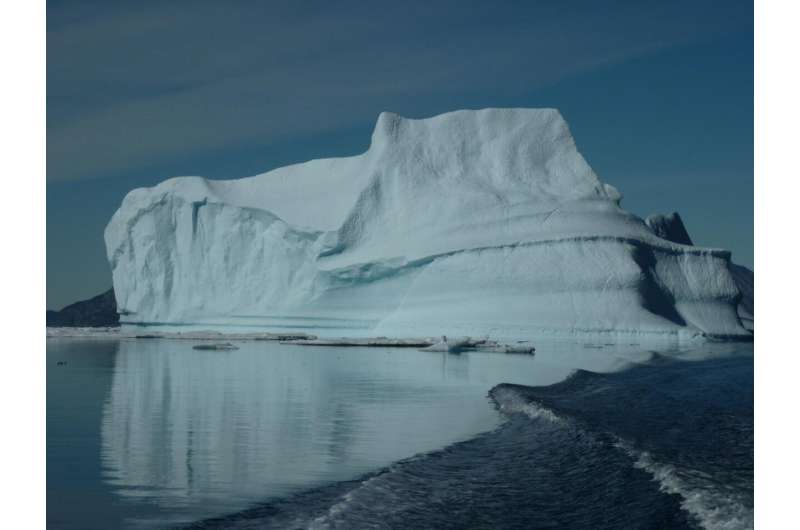Iceberg off Ammassalik Island, southeast Greenland. Credit: Professor Edward Hanna
New analysis of almost 30 years' worth of scientific data on the melting of the Greenland Ice Sheet predicts global sea level rise of at least 10 centimeters by the end of the 21st Century if global warming trends continue.
The estimates, which scientists warn are "conservative" given the powerful effects of changes in weather systems and possible ways of accelerating ice loss, are broadly consistent with recent predictions reported by the Intergovernmental Panel on Climate Change.
Professor Edward Hanna of the University of Lincoln, UK, led an international team involving Belgian, Danish, Swiss and American glaciologists and climatologists in the new study that quantifies the response of the Greenland Ice Sheet to climate change. Their findings are published in the International Journal of Climatology.
The Greenland Ice Sheet is a giant reservoir of ice that contains enough water to ultimately raise global sea-level by seven meters.
The researchers provide an updated analysis of Greenland surface air temperature data for the last three decades through to 2019, focusing mainly on coastal weather stations but also analyzing records from relatively long-running sites on the interior plateau of the ice sheet. They found that Greenland coastal regions warmed significantly by about 4.4 degrees Celsius (degC) in winter and 1.7 degC in summer from 1991 to 2019. Their work, combining Greenland temperature data with computer model output of ice-sheet mass balance for 1972 to 2018, shows that each 1degC of summer warming corresponds to some 91 billion tons per year of surface mass loss and 116 billion tons per year of total mass loss from the ice sheet.
The research team then used some of the latest available global and regional climate modeling tools to estimate that, under sustained strong global warming (a 'business as usual' scenario), Greenland is likely to warm 4.0 to 6.6 degC by the year 2100. These recent and projected future Greenland warmings are considerably greater than global temperature changes for equivalent time periods, reflecting a high sensitivity of the polar regions to climate change.
The scientists then used the relation they derived between recent changes in Greenland summer temperature and surface mass balance to calculate a 10 to 12.5 centimeters increase in global sea-level rise by 2100 arising from increased Greenland ice melt and surface mass loss.
Prof. Hanna's team also explored the relation between Greenland air temperature changes and a phenomenon called atmospheric high pressure blocking which involves a greater than normal mass of air sometimes positioned over Greenland. This relation is generally present but has strengthened in spring and summer in recent decades. The authors show Greenland blocking played a crucial role in the near-record Greenland melt in the summer of 2019 (narrowly surpassed by the all-time record in 2012), and point out that possible future changes in blocking need to be better considered in computer-model projections of climate change.
Prof. Hanna, Professor of Climate Science and Meteorology in Lincoln's School of Geography and Lincoln Centre for Water and Planetary Health, said "The Greenland Ice Sheet is one of the most sensitive and reliable measures of global climate change. Here we have used relatively simple statistical analysis of data and model output from the last 30 years as a sense-check on prediction of future ice-sheet surface mass change. Our work, which represents in part a major updated analysis of Greenland climate records, is highly interdisciplinary since it cross-cuts between climate science and glaciology, and so will help improve interpretation of recent ice-sheet changes."
More information: Edward Hanna et al, Greenland surface air temperature changes from 1981 to 2019 and implications for ice‐sheet melt and mass‐balance change, International Journal of Climatology (2020). DOI: 10.1002/joc.6771
Provided by University of Lincoln
























